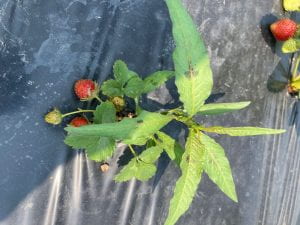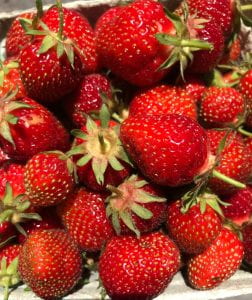It is mid-August, and the strawberry harvest has ended for many growers in New York. Here are some ways to care for your strawberries this time of year, if you are tending to a new planting of June-bearers, or if you have a dayneutral planting.
Check on new plantings of June-bearers:
At this point in the season, some weeds could have established in the planting holes. Hand-weed as soon as possible to keep populations at bay. Any flowers that weren’t pinched off may have turned into fruit. Harvest any ripe berries you see, and remove under-ripe berries to direct the plant’s energy into the root system. Any berries left on the plants could become a source of mold spores the next season. If any flowers are present, pinch them off as well.

Manage runners by directing them into the rows, or cutting them off. Runners can be pinned to the ground using a piece of U-shaped wire to secure them in place.
Harvest dayneutrals:
Let dayneutral strawberries ripen fully: only harvest fruit after it has become entirely red. Fruit size may be smaller than June-bearing strawberries, and marketing dayneutrals in pint containers can help compensate for the high labor investment of harvesting.
Keep plantings watered:
In new plantings, keep the root zone well-watered using irrigation to establish a strong root system. Dayneutral varieties also benefit from large water inputs as their root systems are shallow.
Scout for pests:
Examine leaves for symptoms of two spotted spider mite. If you see spots and discoloration on leaves, it could be either leaf blight, leaf spot or leaf scorch.
Examine any ripe fruits for sap beetles and rots, including rhizopus and mucor fruit rots, leather rot, and anthracnose fruit rot.
Additional Resources
Berry Diagnostic Tool | Cornell University
Strawberry Production Guide | Northeast Regional Agricultural Engineering Service
Strawberry Plant Establishment | Cornell Cooperative Extension
Dayneutral Strawberry Production Guide | Cornell Cooperative Extension

